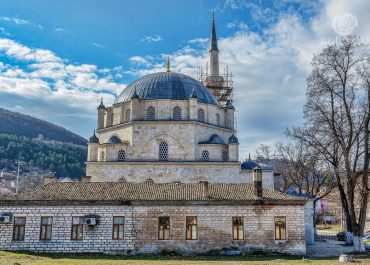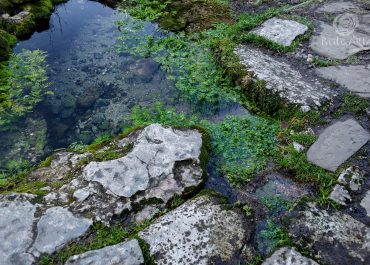
Abritus Archaeological Reserve, Razgrad
Abritus Archaeological Reserve is located 2 km east of Razgrad, near the Ruse – Varna main road. The reserve spreads out on a territory of 1000 decares and is aimed to preserve the remains of the Roman town of Abritus.
Abritus was established at the end of the 1st century AD as a Roman military camp built on the ruins of an ancient Thracian settlement and grew to become one of the biggest urban centres in Moesia Inferior – a Roman province that was situated in the northern part of modern-day Bulgaria.
The town of Abritus was mentioned by ancient authors in relation to the battle that took place in its region in 251 AD, a battle in which Emperor Trajan Decius was killed.
In the 4th century, a fortress with a 3 m-thick and 12 m-high fortified wall, 4 gates and 35 battle towers was built on a territory of 14 hectares. The town was an important Christian centre in the period 5th – 6th centuries. It was destroyed by the Avars and the Slavs at the end of the 6th century. In the end of the 9th century and the beginning of the 10th century, a Bulgarian fortress was built in its place.
On the territory of the reserve, visitors can see the remains of a 3200 sq m peristyle complex (a rectangular inner courtyard and a building) that used to be the residence of a high-ranking state magistrate. Its southern facade is connected to six shops situated on both sides of the main entrance. There are Roman-Ionic columns on the four sides of the inner courtyard. The remains of large farm premises lie in the eastern and the western parts of the complex. The building was used until the end of the 6th century, when the whole town was destroyed.
An archaeological museum is also established on the territory of the reserve, in which some of the artifacts discovered during digs in the region, are exhibited. The archaeological exhibition is divided into five sections that follow the development of human society. The biggest gold coin treasure from the 5th century in Bulgaria was discovered in Abritus. It consists of 835 solidi (coins) and pictures of it can be seen at the museum. Still, a smaller treasure from the 10th century also consisting of solidi, is displayed at the museum.
The big archaeological finds discovered during excavations on the territory of the reserve are kept in an open-air museum. The park section of Abritus preserves 70 epigraphic monuments, most of which date back to Roman times. Here, visitors can also see artifacts related to pagan cults, such as the sacrificial altar dedicated to Hercules that dates back to the reign of Emperor Septimus Severus. The various ancient Greek and Latin inscriptions provide evidence for the diversity of the peoples that inhabited Abritus through the centuries: Romans, Bulgarians and Turks. The epitaphs and the building inscriptions dated from the 18th and the 19th centuries are also of extreme interest to visitors. They derive from the Christian and the Islamic traditions but there is also one that is of Armenian origin.
Visitors can learn more about the reserve if they use the services of a tour guide. Information materials and souvenirs are sold at the museum.
Monday – Sunday
09:30 – 18:00
Guides provide services to visitors of the archaeological reserve.
Lectures are given in Bulgarian.
Tourist Information Center – Razgrad
Monday-Friday: 08:30 – 12:00, 13:00 – 17:30
7200 Ragrad, Sq. “Independence” 2 (building of the Municipal Cultural Center)
Tel: +359 84 66 23 24
E-mail: ticrazgrad@abv.bg
Website: https://www.razgrad.bg/
Regional Historical Museum – Razgrad
Razgrad, 70 Aprilsko Vastanie Blvd.
Tel: +359 84 662 460
Website: abritus.bg
Abritus Archaeological Reserve is located 2 km east of Razgrad, near the Ruse – Varna main road. The reserve spreads out on a territory of 1000 decares and is aimed to preserve the remains of the Roman town of Abritus.
Abritus was established at the end of the 1st century AD as a Roman military camp built on the ruins of an ancient Thracian settlement and grew to become one of the biggest urban centres in Moesia Inferior – a Roman province that was situated in the northern part of modern-day Bulgaria.
The town of Abritus was mentioned by ancient authors in relation to the battle that took place in its region in 251 AD, a battle in which Emperor Trajan Decius was killed.
In the 4th century, a fortress with a 3 m-thick and 12 m-high fortified wall, 4 gates and 35 battle towers was built on a territory of 14 hectares. The town was an important Christian centre in the period 5th – 6th centuries. It was destroyed by the Avars and the Slavs at the end of the 6th century. In the end of the 9th century and the beginning of the 10th century, a Bulgarian fortress was built in its place.
On the territory of the reserve, visitors can see the remains of a 3200 sq m peristyle complex (a rectangular inner courtyard and a building) that used to be the residence of a high-ranking state magistrate. Its southern facade is connected to six shops situated on both sides of the main entrance. There are Roman-Ionic columns on the four sides of the inner courtyard. The remains of large farm premises lie in the eastern and the western parts of the complex. The building was used until the end of the 6th century, when the whole town was destroyed.
An archaeological museum is also established on the territory of the reserve, in which some of the artifacts discovered during digs in the region, are exhibited. The archaeological exhibition is divided into five sections that follow the development of human society. The biggest gold coin treasure from the 5th century in Bulgaria was discovered in Abritus. It consists of 835 solidi (coins) and pictures of it can be seen at the museum. Still, a smaller treasure from the 10th century also consisting of solidi, is displayed at the museum.
The big archaeological finds discovered during excavations on the territory of the reserve are kept in an open-air museum. The park section of Abritus preserves 70 epigraphic monuments, most of which date back to Roman times. Here, visitors can also see artifacts related to pagan cults, such as the sacrificial altar dedicated to Hercules that dates back to the reign of Emperor Septimus Severus. The various ancient Greek and Latin inscriptions provide evidence for the diversity of the peoples that inhabited Abritus through the centuries: Romans, Bulgarians and Turks. The epitaphs and the building inscriptions dated from the 18th and the 19th centuries are also of extreme interest to visitors. They derive from the Christian and the Islamic traditions but there is also one that is of Armenian origin.
Visitors can learn more about the reserve if they use the services of a tour guide. Information materials and souvenirs are sold at the museum.
Monday – Sunday
09:30 – 18:00
Guides provide services to visitors of the archaeological reserve.
Lectures are given in Bulgarian.
Tourist Information Center – Razgrad
Monday-Friday: 08:30 – 12:00, 13:00 – 17:30
7200 Ragrad, Sq. “Independence” 2 (building of the Municipal Cultural Center)
Tel: +359 84 66 23 24
E-mail: ticrazgrad@abv.bg
Website: https://www.razgrad.bg/
Regional Historical Museum – Razgrad
Razgrad, 70 Aprilsko Vastanie Blvd.
Tel: +359 84 662 460
Website: abritus.bg
Virtual map
Photos
© All images, advertising and video materials and/or other information published on this website are property of the Ministry of Tourism and are protected by the Law on Copyright and Related Rights, according to the Bulgarian laws to all applicable international and relevant acts of the European Union.





